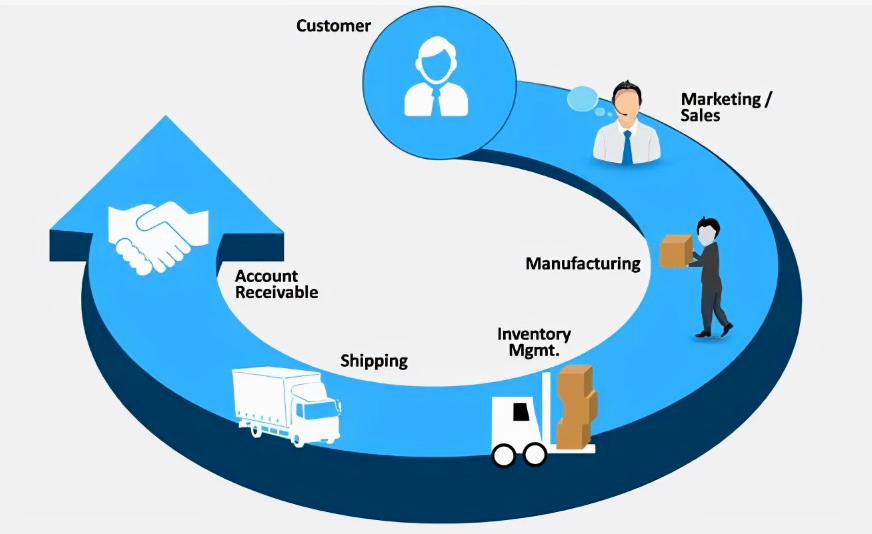I. Introduction
In today’s fast-paced business environment, effective management is the key to success. One approach that has gained significant popularity is end-to-end management. But what exactly is end-to-end management and why is it so crucial in today’s business landscape?
A. Brief explanation of the concept of end-to-end management
End-to-end management refers to the process of overseeing and coordinating all aspects of a project or operation. This holistic approach involves monitoring the entire lifecycle, from the initiation to the final delivery, ensuring smooth progress and successful outcomes. It entails taking into account various interconnected processes, stakeholders, and resources to achieve the desired objectives.
B. Importance of end-to-end management in today’s business environment
In the increasingly complex and interconnected world of business, end-to-end management plays a pivotal role. It allows organizations to take charge of their operations in a comprehensive manner, resulting in several benefits.
Firstly, end-to-end management enables enhanced efficiency. By overseeing the entire process, potential bottlenecks and inefficiencies can be identified early on, allowing for prompt interventions. This can lead to streamlined operations, reduced costs, and improved productivity.
Secondly, end-to-end management promotes effective collaboration. With multiple stakeholders involved in a project, it is crucial to ensure clear communication and coordination between all parties. By adopting an end-to-end approach, organizations can establish seamless collaboration channels, resulting in better alignment, fewer misunderstandings, and increased overall effectiveness.
Moreover, end-to-end management facilitates risk mitigation. By continuously monitoring the entire lifecycle, potential risks and challenges can be identified and addressed promptly. This proactive approach minimizes the likelihood of delays, disruptions, or costly errors, thereby safeguarding the project’s success.
Lastly, end-to-end management empowers organizations to maintain a customer-centric focus. By overseeing the entire process, businesses can identify and address any gaps or pain points in delivering value to their customers. This enables them to enhance customer satisfaction and loyalty, giving them a competitive advantage in today’s market.
In conclusion, end-to-end management is essential in today’s business environment. By adopting this approach, organizations can achieve higher efficiency, collaboration, risk mitigation, and customer-centricity. Embracing end-to-end management ensures that businesses stay ahead in the ever-evolving landscape, delivering successful outcomes and meeting customer expectations.

II. Definition of End-to-End Management
End-to-end management refers to the comprehensive oversight and control of a process from its initiation to its successful completion. It encompasses the management of all stages and aspects within the process, ensuring a seamless and efficient execution from start to finish.
A. Explaining the concept of managing a process from start to finish
Managing a process from start to finish means taking responsibility for every step involved in its execution. It involves coordinating various tasks, resources, and individuals involved in the process, ensuring smooth coordination and communication between different stages. This approach enables a holistic view of the entire process, allowing for improved efficiency, timely completion, and better outcomes.
B. Inclusion of all stages and aspects within the process
End-to-end management is not limited to a specific phase or aspect of a process, but encompasses all stages from initiation to completion. It involves assessing the scope and objectives of the process, coordinating planning and implementation, monitoring progress, and addressing any challenges or roadblocks that arise along the way. By considering all aspects, such as resources, timelines, quality standards, and stakeholder expectations, end-to-end management ensures a comprehensive approach to successfully delivering the desired results.
Incorporating end-to-end management in your processes gives you a holistic understanding of every stage, enabling you to identify potential bottlenecks, optimize resources efficiently, and minimize risks. By adopting a proactive approach, you can anticipate and resolve any issues that may arise, ensuring a streamlined and effective process.
Remember, end-to-end management is not just about getting things done but getting them done in the best possible manner. It enhances collaboration, communication, and coordination among various stakeholders, resulting in improved efficiency, reduced delays, and ultimately, a successful outcome.
So, embrace the concept of end-to-end management and unlock the potential to optimize your processes and enhance your overall organizational effectiveness.
III. Key Components of End-to-End Management
Effective end-to-end management encompasses several key components that ensure seamless operations and optimal outcomes. By adopting a customer-centric approach, integrating relevant systems and individuals, and continuously monitoring and controlling processes, organizations can achieve efficient resource allocation and ultimately enhance customer satisfaction. Below are the key components that contribute to successful end-to-end management:
A. Identification and Mapping of the Complete Process Flow
Understanding the complete process flow is essential for effective management. By meticulously identifying and mapping each step, organizations gain clarity on how various tasks and functions are interconnected. This allows for better coordination, streamlining operations, and identifying potential areas for improvement.
B. Integration of All Relevant Systems and Individuals Involved
Achieving smooth end-to-end management requires the integration of all relevant systems and individuals involved in the process. By fostering collaboration among stakeholders, information and resources can be effectively shared, eliminating silos and promoting synergy. Such integration ensures that everyone is aligned, resulting in increased efficiency and cohesive decision-making.
C. Continuous Monitoring and Control of the Process
A key aspect of effective end-to-end management is the continuous monitoring and control of the process. By closely tracking key performance indicators (KPIs) and utilizing real-time data, organizations can identify bottlenecks, address issues promptly, and proactively adapt strategies for better outcomes. This data-driven approach enables agility and ensures that the process consistently meets business objectives and customer expectations.
D. Efficient Resource Allocation and Optimization
Successful end-to-end management necessitates efficient resource allocation and optimization. By evaluating resource utilization and identifying areas of improvement, organizations can allocate their resources effectively, eliminating wastage and improving productivity. This ensures that resources are distributed in a manner that maximizes output and enhances overall operational efficiency.
E. Emphasis on Customer Satisfaction and Feedback
Customer satisfaction lies at the core of end-to-end management. By placing a strong emphasis on meeting and exceeding customer expectations, organizations can effectively tailor their processes and offerings. Regularly gathering customer feedback is crucial, as it provides valuable insights for continuous improvement and helps in identifying areas where the process can be enhanced to deliver exceptional customer experiences.
Incorporating the above key components into end-to-end management enables organizations to streamline processes, enhance collaboration, optimize resource allocation, and prioritize customer satisfaction. By adopting a holistic approach, businesses can achieve operational excellence and position themselves for sustained success in a rapidly evolving marketplace.
#IV. Benefits of End-to-End Management
Implementing end-to-end management within your organization can yield a multitude of benefits. This section outlines some of the key advantages that can be achieved through such an approach.
##A. Increased operational efficiency and productivity
End-to-end management allows for streamlined workflows and optimized processes. By overseeing the entire lifecycle of a project or task, organizations can identify and eliminate bottlenecks, reduce redundancies, and improve overall operational efficiency. This, in turn, leads to increased productivity as resources are allocated more effectively and tasks are executed seamlessly.
##B. Enhanced collaboration and communication among stakeholders
With end-to-end management, all stakeholders involved in a project or process have a unified view of the entire workflow. This promotes clearer communication and enables stronger collaboration among team members. By breaking down silos and fostering a culture of cross-functional collaboration, organizations can facilitate information sharing, idea generation, and decision-making, ultimately leading to improved outcomes.
##C. Improved quality control and risk management
End-to-end management allows organizations to have greater control over quality assurance and risk management throughout the entire process. By closely monitoring each step and implementing robust quality control measures, organizations can identify and rectify any issues or deviations in real-time. This proactive approach helps to minimize errors, avoid potential risks, and ensure that projects are delivered with the highest level of quality and precision.
##D. Greater visibility into the entire process
One of the significant advantages of end-to-end management is the improved visibility it provides. By having a holistic view of a project or task from start to finish, organizations can track progress, identify potential roadblocks, and make informed decisions. This comprehensive understanding of the process empowers management and teams to take necessary actions, make adjustments as needed, and keep projects on track.
##E. Higher customer satisfaction and loyalty
End-to-end management plays a crucial role in enhancing customer satisfaction and loyalty. With a clear view of the entire process, organizations can better anticipate customer needs, meet their expectations, and deliver products or services on time. The seamless coordination between different departments and efficient handling of customer inquiries or concerns lead to improved customer experiences. Satisfied customers are more likely to become loyal advocates, leading to a positive impact on reputation and overall business growth.
Implementing end-to-end management within your organization brings a plethora of benefits, including increased operational efficiency, better collaboration, improved quality control, greater visibility, and higher customer satisfaction. By embracing this approach, organizations can stand out in their industry, create a positive work environment, and drive success in today’s competitive business landscape.

V. Implementing End-to-End Management in Practice
In order to successfully implement end-to-end management, there are several key steps and considerations that need to be taken into account. By following these guidelines, organizations can ensure effective coordination, seamless process management, and continuous improvement.
A. Identifying the Critical Processes to Manage
The first step towards implementing end-to-end management is to identify the critical processes that need to be managed. This involves a comprehensive analysis of all the activities and tasks involved in delivering a product or service from start to finish. By clearly understanding each process and its dependencies, organizations can begin to streamline operations and eliminate inefficiencies.
B. Building Cross-Functional Teams for Effective Coordination
Next, it is crucial to build cross-functional teams that can effectively coordinate the various processes involved in end-to-end management. These teams should consist of individuals from different departments or functional areas who possess unique expertise and perspectives. By fostering collaboration and communication among team members, organizations can break down silos and ensure seamless coordination across the entire value chain.
C. Selecting the Right Tools and Technologies
To facilitate effective end-to-end management, organizations must carefully select the right tools and technologies. These tools should be user-friendly, scalable, and capable of integrating with existing systems. They should automate repetitive tasks, provide real-time data, and enable efficient communication and collaboration across teams. Investing in robust and adaptable technologies will lay the foundation for successful end-to-end management.
D. Establishing Performance Metrics and Benchmarks
To measure the effectiveness and efficiency of end-to-end management, it is essential to establish performance metrics and benchmarks. These metrics should align with the organization’s goals and objectives, and they should be regularly monitored and evaluated. By tracking key performance indicators, organizations can identify areas for improvement, celebrate successes, and ensure that end-to-end management is driving desired outcomes.
E. Regular Evaluation and Continuous Improvement
Lastly, implementing end-to-end management requires regular evaluation and continuous improvement. This involves conducting periodic audits, surveys, and feedback sessions to assess the effectiveness of the implemented strategies and processes. Through this continuous improvement cycle, organizations can identify opportunities for further optimization, address emerging challenges, and stay ahead in an ever-evolving business landscape.
By following these steps, organizations can successfully implement end-to-end management, improve operational efficiency, and enhance customer satisfaction. Implementing end-to-end management is an ongoing process that requires dedication, collaboration, and a commitment to continuously refining and optimizing business processes.
VI. Real-world Examples of Successful End-to-End Management
As businesses strive to optimize their processes and ensure seamless operations, successful examples of end-to-end management implementation offer valuable insights. In this section, we will explore a case study that showcases positive outcomes achieved through effective end-to-end management. Additionally, we will discuss the lessons learned and highlight best practices derived from this example.
A. Case Study: [Name of the Company/Initiative]
[Provide a brief overview of the company or initiative, explaining its industry and context.]
Positive Outcomes
[Describe the positive outcomes achieved by implementing end-to-end management in this case study or example. Highlight specific improvements, such as cost savings, efficiency gains, customer satisfaction, or any quantifiable results obtained.]
Lessons Learned and Best Practices
[Outline the key lessons learned and best practices derived from this example. Discuss the strategies, methodologies, or approaches employed by the company/initiative that played a pivotal role in their success. Emphasize the crucial factors that contributed to the positive outcomes witnessed.]
B. Best Practices for Successful End-to-End Management
Based on a comprehensive analysis of successful examples, the following best practices have been identified:
- Clear End-to-End Visibility: Maintain a holistic view of your entire organization’s processes and operations to identify potential bottlenecks or areas for improvement. By having a comprehensive understanding of your end-to-end workflow, you can effectively manage and optimize each step.
- Collaborative Approach: Foster open communication and collaboration between different departments and stakeholders involved in the end-to-end process. Encourage cross-functional teams to work together towards a shared goal, ensuring alignment and integration across the organization.
- Data-Driven Decision Making: Leverage data analytics and relevant metrics to make informed decisions. Use real-time data to monitor processes, identify trends, and proactively address any issues. With data as a foundation, you can optimize your operations and drive continuous improvement.
- Continuous Process Improvement: Implement a culture of continuous improvement, embracing innovation and agility. Encourage employees to provide feedback, identify improvement opportunities, and drive efficiency at every stage of the end-to-end process. Regularly evaluate and update your workflows to align with evolving business needs.
- Automation and Technology Adoption: Integrate suitable technological solutions and automation tools to streamline workflows and eliminate manual errors. Leverage technologies like process automation, artificial intelligence, and machine learning to enhance efficiency and reduce costs while ensuring accuracy and reliability.
By incorporating these best practices into your end-to-end management strategy, you can drive positive outcomes and position your organization for sustained success.
Note: Remember that every organization is unique, and while these best practices provide valuable insights, tailoring them to your specific context and requirements is essential.
In conclusion, understanding and implementing end-to-end management based on proven examples and best practices can significantly improve your organization’s performance, competitiveness, and overall customer satisfaction.

VII. Criticisms and Challenges of End-to-End Management
End-to-End Management, while being a valuable approach for achieving efficiency and effectiveness in business operations, does have its fair share of criticisms and challenges. In this section, we will address some potential drawbacks and limitations of this management approach, discuss strategies to overcome resistance to change and siloed thinking, and explore how to handle complex and interconnected processes.
A. Addressing potential drawbacks and limitations
End-to-End Management, like any other management approach, is not without its drawbacks and limitations. It is crucial to be aware of these potential challenges in order to make informed decisions and effectively implement this approach. Some of the criticisms and limitations to consider include:
- Increased complexity: Implementing an End-to-End Management system can introduce additional complexities, particularly in organizations with pre-existing processes and structures. The integration of multiple functions and departments may require thorough planning and coordination to minimize disruptions.
- Resource allocation: Shifting towards an end-to-end approach may necessitate resource realignment, potentially leading to resistance from departments or individuals reluctant to relinquish control. Adequate resource allocation must be carefully planned and communicated to ensure smooth adoption.
- Potential for slower decision-making: End-to-End Management emphasizes collaboration and consensus-building, which can occasionally slow down decision-making processes. Balancing the need for involvement and efficient decision-making is vital to maintain operational agility.
To address these potential drawbacks, organizations should conduct thorough planning, engage in effective change management, and ensure strong leadership support throughout the implementation process. Clear communication and training programs can also help employees understand the benefits and objectives of End-to-End Management, thus reducing resistance and increasing buy-in.
B. Overcoming resistance to change and siloed thinking
One of the significant challenges in implementing End-to-End Management is overcoming resistance to change, particularly when it challenges established siloed thinking. Resistance can arise from individuals or departments unwilling to shift from traditional, compartmentalized approaches to a more integrated and collaborative system. To overcome this resistance, organizations can consider the following strategies:
- Effective communication: Clearly articulate the rationale behind adopting End-to-End Management and how it aligns with the broader organizational objectives. Openly address concerns and provide a platform for employees to voice their opinions and ask questions.
- Leading by example: Encourage senior executives and influential leaders to embrace, champion, and demonstrate the benefits of the new approach. When employees witness their leaders embracing change, it can significantly influence their perception and willingness to adapt.
- Training and support: Provide comprehensive training programs and support resources to equip employees with the necessary skills and knowledge to operate within an End-to-End Management framework. This can help them navigate the change effectively and build confidence in their ability to contribute to the overall success of the organization.
By implementing these strategies, organizations can foster a culture of openness, collaboration, and continuous improvement, breaking down silos and ensuring a more seamless implementation of the End-to-End Management approach.
C. Dealing with complex and interconnected processes
End-to-End Management necessitates managing and optimizing complex and interconnected processes across various functions and departments. Understanding and effectively dealing with this complexity is crucial for successful implementation. To navigate these intricacies, organizations can consider the following approaches:
- Process mapping and analysis: Undertake a comprehensive analysis of existing processes to identify interdependencies, bottlenecks, and areas for improvement. Documenting these processes through visual process mapping can highlight opportunities for streamlining and enhancing efficiency.
- Cross-functional collaboration: Encourage collaboration and communication among different teams and departments involved in the end-to-end processes. Foster a culture of shared ownership and responsibility, emphasizing the collective goal of delivering value to the customers.
- Technology integration: Leverage technology solutions such as enterprise resource planning (ERP) systems, project management software, and data analytics tools to facilitate seamless integration and visibility across various processes. These tools can enhance coordination, streamline data flow, and improve decision-making.
Dealing with complexity requires a systematic and proactive approach. By continuously monitoring and adapting to evolving needs, organizations can address interdependencies while keeping their operations aligned with the overarching goals of End-to-End Management.
In conclusion, while End-to-End Management offers numerous benefits, it is essential to acknowledge and mitigate its potential drawbacks and challenges. By addressing limitations, overcoming resistance to change, and effectively managing complex interconnected processes, organizations can maximize the advantages of this approach and achieve enhanced operational efficiency and customer satisfaction.
VIII. Conclusion
In conclusion, the significance and advantages of end-to-end management cannot be overstated. By adopting this approach, businesses can streamline their operations, enhance efficiency, and achieve a more cohesive workflow. We strongly encourage companies to embrace and implement this strategy, as it can lead to increased productivity, improved customer satisfaction, and ultimately, long-term success. Let us begin this transformative journey together.
Olam Lighting as a factory for 14 years, our customer sales management system (CRM system) and order management system (ERP system) can very well cooperate with customers’ orders (a complete end-to-end management).
Tips:
What is CRM?
CRM customer sales management system is built on the basis of enterprise information management, through the software system to optimize the integration of enterprise business processes, to achieve the rapid response ability of enterprises to market, sales and service, so as to improve working efficiency.

What is ERP?
What is an ERP system? The full name of ERP is Enterprise Resources Planning, that is, enterprise resource planning, which was proposed by the international consulting company Gartner in 1990. It is a software system to help enterprises comprehensively manage business operations, and an integrated enterprise management software for material resource management (logistics), human resource management (people flow), financial resource management (financial flow), and information resource management (information flow).

ERP system uses information technology to systematize management ideas, and provides a management platform for decision-making and operation means for enterprise decision makers and employees. The enterprise’s finance, manpower, procurement, production, sales, inventory and other business functions are integrated into an information management platform, so as to achieve the standardization of information data, the integration of system operation, the rationalization of business processes, the dynamic performance monitoring, and the sustainable management improvement



